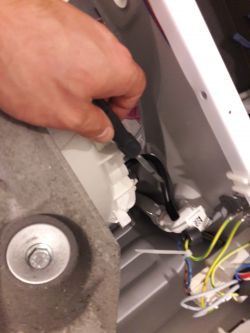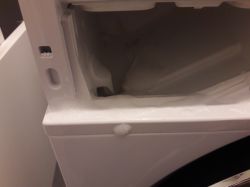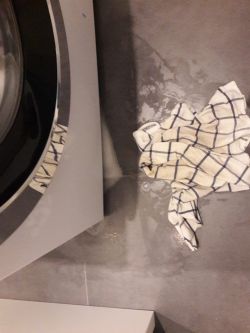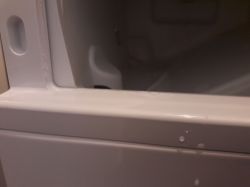FAQ
TL;DR: If your Beko WMY81243PLPTLMB1 leaks 50–200 ml of foamy water from the drawer, “the vent was actually a bit dirty.” Clean the dispenser vent and hoses, then run a hot test cycle to verify. [Elektroda, alvaroalvaro, post #17431661]
Why it matters: This helps Beko owners fix drawer leaks fast at home and avoid long service delays.
Quick Facts
- Symptom range: 50–200 ml of foamy water may exit via the detergent drawer during rinses or hot cycles. [Elektroda, alvaroalvaro, post #17431661]
- Likely cause: a clogged dispenser vent or its hose (dephlegmator) restricting air return to the tank. [Elektroda, Kenworth 18, post #17430823]
- Quick isolation: Switching from capsules to liquid stopped the leak in this case. [Elektroda, alvaroalvaro, post #17437395]
- Setup sensitivity: A washer tilted forward can push water toward the drawer; leveling fixed one case. [Elektroda, Chupacabra, post #17432326]
- Diagnostic run example: Empty 90°C, ~2h40 cycle without detergent still showed minor leakage pre-fix. [Elektroda, alvaroalvaro, post #17432468]
Why is my Beko WMY81243 leaking from the detergent drawer?
Restricted venting between the drawer and tank lets water back up into the dispenser. Foam and water then exit the front. “The description indicates a clogged dispenser vent.” Inspect the dispenser’s vent path and any hose linking it to the tub. On some units the vent is in the drawer housing. Others use a short hose to the tank (dephlegmator). Clean these passages and retest. [Elektroda, Kenworth 18, post #17430823]
How much water is normal to see with this fault?
In this case, leakage ranged from about 50–200 ml and appeared as foamy suds. It tended to show during rinsing or a hot cycle. Treat anything in this range as a sign of a restricted vent path. [Elektroda, alvaroalvaro, post #17431661]
Can detergent capsules trigger overflow from the drawer?
They can contribute. A quick isolation step is to change detergent format. In this thread, the leak disappeared after switching to liquid detergent. If your leak stops, capsules or dosing may have aggravated the issue. [Elektroda, alvaroalvaro, post #17437395]
How do I clean the dispenser vent and hoses?
- Remove and disassemble the detergent drawer and housing.
- Blow out drawer channels, supply hoses, the vent elbow, and drain hose with compressed air.
- Reassemble and run a test wash while monitoring the drawer.
The OP found the vent hose slightly dirty. [Elektroda, alvaroalvaro, post #17432205]
How do I run a simple diagnostic wash?
Run the longest, hottest program empty, without detergent, and with spin off. On this model, a 90°C, 2h40 cycle still produced a small drawer leak before changing detergents. Watch the drawer during fills and rinses. Slight rear tilt was also tested. [Elektroda, alvaroalvaro, post #17432468]
Does leveling the washer affect drawer leaks?
Yes. One user found the washer slightly tilted forward. Leveling it with a spirit level stopped the drawer spill. Check both planes and adjust the feet until level. Recheck after moving the washer. [Elektroda, Chupacabra, post #17432326]
What should I check next if vents look clear?
Clean the pump–tank hose and the drain pump. On this design, the vent hose connects to an elbow that is part of the drain system. A partial clog here can disturb venting and push water toward the drawer. [Elektroda, Kenworth 18, post #17433057]
Could a faulty valve or hydrostat cause this?
Yes. A stuck inlet valve or a defective water level sensor (hydrostat) can overfill the tub and route water toward the drawer. Check these after confirming vent and hose cleanliness. [Elektroda, mblazynski, post #17430753]
Where exactly is the vent path on this Beko?
The vent can be part of the detergent dispenser body. Other versions route a short hose from the dispenser to the tank, sometimes called a dephlegmator. Inspect and clear both, depending on your unit’s build. [Elektroda, Kenworth 18, post #17430823]
How do I isolate detergent as the cause without dismantling?
Run a cycle without detergent and without a load. Use the longest program at the highest temperature. If the drawer stays dry, repeat with detergent to compare. “Try washing without detergents and without loading.” [Elektroda, Kenworth 18, post #17432221]
What tools help clean the drawer and hoses?
Use compressed air from a compressor to blow out the detergent drawer, its channels, and the supply and vent hoses. Remove the elbow and drain hose for clearing. Reassemble and test. The vent hose showed slight dirt in this case. [Elektroda, alvaroalvaro, post #17432205]
Is one capsule per wash too much for this machine?
The OP used one capsule per wash, and leakage still occurred before changing detergents. If you suspect over-foaming, compare results using a different detergent format. [Elektroda, alvaroalvaro, post #17431661]
Which replacement parts cover the drawer and vent area?
Look for the detergent drawer chamber and the lower powder container chamber specific to the WMY 81243 PTLMB1. These assemblies include the vent path. “Sometimes this vent is part of the detergent dispenser.” [Elektroda, Kenworth 18, post #17430823]
Are clogged rubber hoses a known issue here?
Yes. Clogged rubber hoses connected to the drawer can restrict water flow and venting. Remove and clear these hoses during inspection, then refit them securely. [Elektroda, sedziak, post #17432151]







